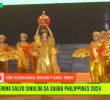by DON J. PAGUSARA
Davao Today
Time and again I say we Filipinos are a miseducated people. Our education works for the interest, glory and honor of foreigners, most especially the Americans.
Because of colonialism ours has been an educational system imported from America. Once we get educated under this system we are shaped into the mold of a miseducated Filipino. We are made to imbibe a foreign culture that has made of ourselves strangers to our own traditions, culture and history. This foreign culture infused into our soul make us proud to be kalokalike — of Americans primarily, or of Spaniards or of any Caucasian for that matter.
And of course — and I’ll never get tired of repeating this: the educated or schooled Filipino always loves and speaks the language not his/her own. Even if he/she has not completed secondary or tertiary education, he/she still loves to speak English. Given the slightest opportunity to speak his/her mind, he/she will try hard to speak English in the most affected manner he/she can. Bisag mahimo pang kataw-anan!
And the malleable ones — those gifted with linguistic adaptability –would swagger around with chips on their shoulders. They think they are the most blest and are the most empowered among the less equals.
Yes, the English-speaking Filipinos carry with certain hubris their skill of the English language and gloat with this in varying levels of empowerment. English in our society is the language of the powerful!
And our artists? Most especially the literary artists — the poets, the fictionists, the essayists? They who make use of language medium to transport their art from the realm of their souls to the eyes and ears of the world? What has this phenomenon of miseducation made of their artistic sensibilities?
First and foremost, they write in English. They frown upon any literary craft rendered in the indigenous tongue. To most of them, English is the most exquisite language in the world. And woe to those who cannot deliver their artistic expressiveness in this medium for they would be the “least” among equals. And so, you will be someone queer and be part of a species of deviants if you use a Filipino language in your writing.
But, to be writing in one’s own tongue is not exactly a saving grace. Because even among those who write in the indigenous tongue many have not been spared from the virus of colonial mentality! Yes, they may have loved their own tongue and have attained mastery over its employ in their literature. Yes, their crafts may be dressed up in the vernacular idioms or local modes of expression. What about the themes, the models and paradigms, the formal patterns and standards, and other elements of poetics they adopt? And above all, what world outlook governs their crafts?
A stark example of colonial-mindedness among our artists is the use of mythical allusions in their poetry. Whether in English or in Cebuano or in Tagalog, most Filipino poet or artist adheres to the Western mythology, particularly Greek or Roman mythology as references in the celebration of the themes and or messages of their obra maestra. And where do they derive this habit and practice? Where else but from the English or western poetry and artists.
We are so conversant of western myths, and yet are utterly ignorant of our own myths and legends. The names Zeus, Apollo and Athena, Cupid and Venus, and so forth are readily mumbled by our lips. But our very own Tudbulul, Tuwaang, Mebuyan, Magbabaya, Mannama, Mandalangan and other names in the Mindanao myths and legends are strange to us! Something remote to our minds.
We know very well and are even “kilig to the bones” about the love story of Paris and Helen in the Greek mythology, but never heard of the loves and adventures of Tuwaang, the epic hero of the Manobo!
Why are we not made to learn the stories and epics of our very own folklores? Why are these significant treasures about our own racial and historical roots not made “musts” in our school curricula? Why are things of utmost importance to the recognition and understanding of our own culture and traditions absent in the classroom lessons?
Such that these precious things about our lore and folktales are also absent in the cerebral tissues of our brains? And instead, we are very knowledgeable about “Cinderella” and ”Rapunzel”?
Just as we are familiar with the taste of the ginamos or the buwad in our daily meals and the panga sa barilis in our special occasional meals, it is imperative that we are familiar with the stories and lore of our very own mythology. We can start with the Mindanao myths and legends and climb up to the Visayan shores, then upper still to the Luzon hills and Cordillera mountains.
Here in Mindanao, if we have such intriguing tales about Tuwaang and the Mo’nawon maiden of the Manobos, Tudbulol and Kepawan of the T’boli, and there in the Cordillera they have Banna and Lagunawa of the Kalinga, waiting to be heard and retold.
Such classroom learnings as this would make us aware and conscious always of our links to our remote past. Through these Lumad folklores we will have a way of peeping into the microcosm of the long-forgotten society of our pre-conquest forebears.
Then shall we become truly proud to be Filipino not on account of our being half-American and half-Pinoy, or half-German and half-Pinoy, or half-alien and half-Pinoy, but because we are certain about our racial roots and can trace our blood and birthright to our ancestral beginnings, irrespective of whether our skin is the color of earth or the texture of the durian peeling.
And our poets and artists won’t have to look for legendary figures in foreign lands as allusions to celebrate the themes of their poetry and or artistic crafts. Right here in our own backyards are marvelous tales and lore spilled over through times past. And we would be like veritable “gleaners’ of the lost treasures of our own myths — things
we can cherish and pass over to our children and the children of future generations.
Nganong molakbay pa man ta ngadto sa langyawng yuta aron lang mangalap og panagway sa mga tawong ikasaulog sa atong mga alampat nga dinhi sa
atong kaugalingong tugkaran naay daghang nangigdal nga mga lugas sa
mga sugilanon sa atong katigulangan. (Davao Today)










